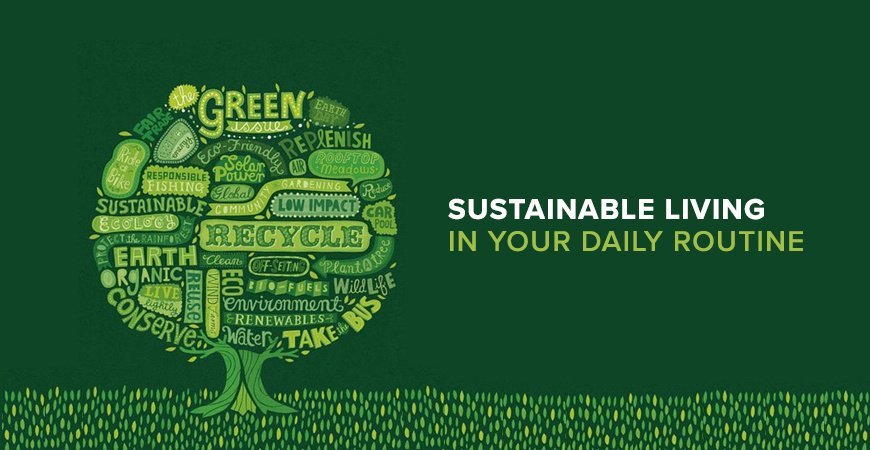Sustainable living refers to adopting lifestyle choices that minimize environmental impact, conserve resources, and promote long-term ecological balance. It involves changes in how we produce, consume, and dispose of resources, while prioritizing environmental health, social equity, and economic resilience.

1. Energy Conservation
- Why: Reducing energy consumption helps lower greenhouse gas emissions and conserves natural resources.
- Actions:
- Switch to renewable energy: Use solar, wind, or other renewable energy sources when possible.
- Use energy-efficient appliances: Choose products with high energy-efficiency ratings (e.g., LED lights, Energy Star appliances).
- Turn off unused electronics: Unplug devices or use power strips to minimize standby power consumption.
- Improve home insulation: Keep your home cooler in summer and warmer in winter, reducing the need for heating and cooling.
2. Water Conservation
- Why: Freshwater is a limited resource, and conserving water helps ensure its availability for future generations.
- Actions:
- Fix leaks promptly: Small leaks can waste huge amounts of water over time.
- Install water-saving devices: Use low-flow showerheads, faucets, and toilets.
- Collect rainwater: Set up rainwater harvesting systems to use water for gardening, cleaning, or other non-potable needs.
- Practice mindful water use: Be conscious of how much water you’re using while washing dishes, brushing teeth, or watering plants.
3. Waste Reduction and Recycling
- Why: Waste production puts strain on landfills, harms ecosystems, and contributes to pollution.
- Actions:
- Reduce, reuse, and recycle: Cut down on single-use plastics, reuse items, and ensure recyclables go to the correct bins.
- Composting: Compost organic waste like food scraps, which can enrich soil and reduce landfill waste.
- Buy in bulk: Reduce packaging waste by buying items in larger quantities.
- Support circular economies: Purchase products from companies that use recycled materials or adopt circular production methods.
4. Sustainable Food Choices
- Why: The food system has a significant environmental footprint, from agricultural practices to transportation and packaging.
- Actions:
- Eat local and seasonal: Support local farmers and reduce the carbon footprint associated with long-distance food transport.
- Reduce meat consumption: Meat production requires a large amount of resources, and shifting towards plant-based eating helps reduce environmental impact.
- Minimize food waste: Plan meals to avoid over-purchasing, and use leftovers creatively.
- Support sustainable agriculture: Purchase food that is grown with minimal environmental impact, such as organic or regenerative farming methods.
5. Sustainable Transportation
- Why: Transportation is one of the largest contributors to air pollution and greenhouse gas emissions.
- Actions:
- Use public transportation: Buses, trains, and subways reduce the number of private vehicles on the road.
- Carpooling and shared mobility: Share rides with others to lower emissions and reduce traffic congestion.
- Switch to electric vehicles (EVs): EVs are more energy-efficient and produce fewer emissions compared to traditional cars.
- Opt for non-motorized transportation: Walking or cycling for short trips not only reduces emissions but also improves health.
6. Sustainable Fashion
- Why: The fashion industry is a major polluter, from resource extraction to manufacturing and disposal.
- Actions:
- Buy less, choose wisely: Prioritize quality over quantity and purchase items that are versatile and durable.
- Support eco-friendly brands: Look for clothing brands that use sustainable materials (e.g., organic cotton, hemp) and ethical labor practices.
- Upcycle and repurpose: Instead of discarding old clothes, consider donating, repairing, or transforming them into something new.
- Avoid fast fashion: Fast fashion contributes to waste and environmental damage, so aim for timeless, high-quality pieces.
7. Green Building and Home Design
- Why: Buildings consume large amounts of energy and materials, contributing to waste and environmental harm.
- Actions:
- Use sustainable building materials: Opt for materials that are renewable, non-toxic, or recycled.
- Design with energy efficiency in mind: Incorporate features like passive solar heating, natural ventilation, and energy-efficient insulation.
- Green roofs and gardens: These can reduce heat absorption, improve air quality, and help manage stormwater.
- Zero-waste homes: Build or renovate homes with the aim of minimizing waste, from construction to daily living.
8. Promoting Biodiversity
- Why: Biodiversity loss disrupts ecosystems and impacts human well-being by affecting food security and disease regulation.
- Actions:
- Plant native species: Support local biodiversity by planting native plants that are adapted to your local environment.
- Create habitats: Support or create wildlife habitats, whether in urban areas (like rooftop gardens) or rural areas (such as sustainable farms).
- Conserve forests and ecosystems: Support policies and initiatives that protect natural habitats from destruction and degradation.
9. Mindful Consumption
- Why: Overconsumption of goods and resources leads to environmental degradation and social inequality.
- Actions:
- Practice minimalism: Prioritize experiences over material possessions, and choose to buy fewer but more meaningful items.
- Support ethical businesses: Choose products and companies that align with sustainable practices and social responsibility.
- Educate yourself: Learn about the environmental and social impacts of the products you buy and make conscious decisions.
10. Sustainable Communities and Advocacy
- Why: Collective action is needed to drive large-scale change, particularly in tackling climate change, waste, and social inequality.
- Actions:
- Join or start local sustainability initiatives: Participate in community clean-up drives, tree planting, or renewable energy projects.
- Advocate for policy change: Support policies and regulations that promote environmental protection, renewable energy, and sustainable development.
- Educate others: Share knowledge about sustainability practices and encourage others to adopt eco-friendly habits.
* Conclusion *
Sustainable living is not just about individual actions but also about fostering a culture of sustainability in communities, businesses, and governments. By adopting sustainable practices in daily life, we can help mitigate environmental harm, conserve resources, and create a more equitable and resilient world for future generations. Every small change can make a difference when it comes to sustainability, so start with one step and build momentum!
